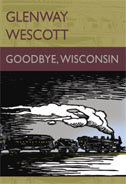Goodbye Wisconsin
by Glenway Wescott
Wisconsin was still a wilderness in these early 1920s stories by Glenway Wescott (1901–1987). The distances between farms and small towns seemed great in those days. So was the struggle of social order and religion against the dangers of poverty, nature, and a stubborn streak of lawlessness. But the real adventure in these stories is in Wescott's deep understanding of human nature and his levels of meaning. His characters may be tragic, heroic, comic or inspiring, but if there is one theme here, it is the search for personal freedom.
Originally published in 1928, Goodbye, Wisconsin followed Wescott's other Midwestern fiction, the acclaimed first novel The Apple of the Eye (1924) and his Harper Prize Award-winning The Grandmothers (1927), which at the time brought him fame equal to Ernest Hemingway and F. Scott Fitzgerald among the American expatriates in France. After an unsuccessful decade back in America, Wescott rebounded with one of the great short novels in English, The Pilgrim Hawk (1940) and the best-selling World War II novel, Apartment in Athens (1945). His late work was graced by lyrical essays and journals. But it is in his early Midwestern writing that his reputation abides. Goodbye, Wisconsin reflects that creative decade of the 1920s, when he was in his 20s, mixing auspicious early stories with those written when he was living in Paris, looking back at his native land.
These stories are the fiction writer's rendering of real stories, rumors, gossip and local legend. But there is also the perspective that the individual writer brings to his work. In Wescott that includes respect for Midwest courtesy and decency, but animosity toward the old-fashioned puritanism that stifles creativity and humanity. It includes a love of the landscape even when it is impoverished, and of nature even when it is cruel. – From the Introduction by Jerry Rosco
These stories by Glenway Wescott may be read with pleasure, and reread, for every reading brings out new shades of meaning and richness of feeling. The plain but dense style, full of warmth and reservations, can be misleading: it makes things seem simple. Better look again. You are reading the stories of one of the best-endowed writers this country has ever produced. – Katherine Anne Porter
What a wonderful life. A life dedicated with a saintlike monomania to the art of writing and the world of letters—so crammed with friendships with gifted people, so rich in the pleasures of the eye and the mind. – William Maxwell
Glenway Wescott turned his literary talent into a relentless and lifelong search of himself as a homosexual with the vain hope that it would yield a better and more intimate understanding of his midwestern landscape, family members, lovers, and friends. He believed that such an endeavor could provide not only the necessary answers but explain to others, in an intuitive and nonscientific way, his own worthiness and humanity. – Anatole Pohorilenko, When We Were Three
186 pp. 5 1/2 x 8 3/8 inches
Illustrated by Steve Chappell
$26 Cloth
ISBN 978-0-9768781-7-9
2008
